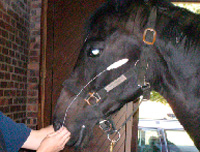Collection of samples in horses using a nasopharyngeal swab
When should a swab be taken?
The collection of samples using a nasopharyngeal swab is necessary in the majority of horses presenting with respiratory or neurological signs, for the diagnosis of the following etiologic agents:

Dr. Jamie Gartside (Tay Valley Vets, Reino Unido), British Horse Society Scotland, STEPS (Strategy To Eradicate and Prevent Strangles).
Bacterial agents:
- Streptococcus equi subsp. equi (equine strangles)
- Streptococcus equi subsp. zooepidemicus (pneumonia)
- Rhodococcus equi (pneumonia)
- Other bacterial respiratory problems
Agentes víricos:
- Equine Herpesvirus type 1, Equine Herpesvirus type 4 (equine rhinopneumonitis, myeloencephalopathy)
- Equine Herpesvirus type 2, Equine Herpesvirus type 5 (respiratory disease)
- Equine Influenza Virus (equine influenza)
- Equine Arteritis Virus (equine viral arteritis)
- Equine Adenovirus (respiratory disease)
- Equine Rhinovirus (respiratory disease)
- West Nile Virus (West Nile fever, encephalitis)
How should a swab be taken?
It is important that the swab collects sample from the back of the pharynx. Therefore, the use of our nasopharyngeal swabs is highly recommended. These swabs have the appropriate length (horse or pony size) and an absorbent head. These swabs are available and can be sent from our laboratory upon request seviseq@ucm.es.
Method of collection for nasopharyngeal swabs:
- Prior to introducing the swab, it can be dampened in transport medium or sterile saline.
- The swab must be introduced via the ventral nasal meatus to the back of the throat. The distance is approximately similar to that from the nostril to the eye.
- The swab should be moved gently in order to collect sample from the mucosa. Swallowing indicates the correct depth of swab penetration.
- After moving the swab and the induction of swallowing, the swab should be removed.
- The swab must be immediately placed in a tube with transport medium or sterile saline.
- The swab wire can be broken by using wire cutters or by repeated bending.
- The tube that contains the swab head must be closed safely in order to prevent contamination or leaks. The tube should be named with the name of the horse and the date of sample collection.
The swab should be sent as soon as possible to the laboratory (it should arrive to the laboratory in less than 48 hours) and should be accompanied by the corresponding submission form. Download Analysis Request Form from www.seviseq.es.
For further information and the consultation of questions regarding the diagnosis, treatment or control of an outbreak of strangles:
Equine Health Surveillance Unit
VISAVET Health Surveillance Centre
Complutense University Madrid (Spain)
Tel.: (+34) 913943999
seviseq@ucm.es


